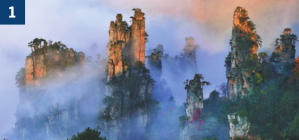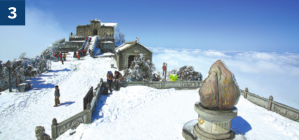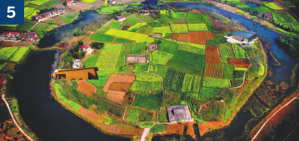Located in the hinterland south of the Yangtze River, Hunan province is home to numerous tourist spots such as Zhangjiajie National Forest Park, Hengshan Mountain, Fenghuang ancient town and Yueyang Tower. On Aug 5, Zhang Qingwei, Party secretary of Hunan, said the province will explore and display the beauty of Hunan's unique tourism by focusing on five key aspects to create a world-class tourist destination. These "five tourism keys" are the natural landscape represented by Zhangjiajie National Forest Park, classic Red tourism routes, historical and cultural sites, urban views and farming culture.
1 Natural landscape
Zhangjiajie, with its thousands of towering peaks, is among China's first batch of world natural heritage sites and one of China's first national forest parks.
The scenic area has vertical and horizontal ravines, immense rock summits, green trees and vines, and flocks of animals and birds.
Dongjiang Lake is located in Chenzhou city, Hunan province. It has served as a water reservation reservoir ever since it was built in 1994. Known as "South Dongting Lake", the Dongjiang Lake possesses a surface area of 160 square kilometers and has a water storage capacity of 81.2 cubic meters. As the biggest artificial lake in the middle and southern area of China, it is also a training base for water sports such as kayaking and water-bicycling.
2 Red tourism
Shaoshan, named after Emperor Shun's southern tour to play Shao music, became famous within China and abroad for being the birthplace of the late Chinese leader Mao Zedong, and Hunan was also called "the hometown of great men".
Today's Shaoshan, with green pines, bamboos and natural beauty, is a national demonstration base for patriotism education, a national-level scenic spot, an outstanding tourist city in China, and a national 5A-level tourist attraction. It receives more than 1 million tourists every year.
Shibadong village in Huayuan county in western Hunan is the place where "targeted poverty alleviation" was initiated.
Since 2013, it has not only found a "reproducible and popularized" way of rural vitalization, but also embarked on a new road of "tourism plus industrial development model".
The per capita net income of Shibadong has increased from 1,668 yuan in 2013 to 20,167 yuan, becoming a microcosm of China's major historic achievements in poverty alleviation.
3 History and culture
Hengshan Mountain, also known as Nanyue, is one of the Five Sacred Mountains in China. It is a famous Taoist and Buddhist holy site. There are more than 200 temples and nunneries in the mountain. Zhu Rong, the god of fire in Hengshan Mountain, taught the people to use fire and cultivate all things. After his death, he was buried in Hengshan. Zhu also became the name of China's first Mars rover. Due to the ideal climate conditions in Hengshan, there are lush forests and bamboo thickets everywhere and exotic flowers and plants that remain fragrant throughout the four seapeople to use fire and cultivate all things. After his death, he was buried in Hengshan. Zhu also became the name of China's first Mars rover. Due to the ideal climate conditions in Hengshan, there are lush forests and bamboo thickets everywhere and exotic flowers and plants that remain fragrant throughout the four seasons. The Mausoleum of Emperor Yan in Zhuzhou, surrounded by green hills and clear waters, is the first of the"Top 10 Cultural Heritages in Hunan". After thousands of years of historical changes, the mausoleum has become a resort for the Chinese to pay tribute to their ancestors and study the culture of Emperor Yan.
Yuelu Academy, at the foot of the Yuelu Mountain, was founded more than 1,000 years ago in 976 AD and is one of the four major academies of ancient China. In 1903, Yuelu Academy was restructured into Hunan Higher School, and in 1926, it was officially named Hunan University. This is the source of local culture and a base for the gestation of ideas and academic innovation across the history of Chinese culture. It is also a microcosm of the long history of China's higher education development and one of the oldest universities in the world's higher education history.
4 Urban view
As the provincial capital of Hunan, Changsha is famous for cultural tourism consumption, night markets and diverse businesses. In recent years, Changsha has vigorously developed the nighttime cultural tourism economy and has been selected among one of the"Top 10 Influential Cities in China's Nighttime Economy" for three consecutive years.
Taiping ancient alley in Changsha, which was selected as the first batch of national-level tourist and leisure blocks, has daily traffic of more than 100,000 people.
5 Farming culture
Chengtoushan National Archaeological Site Park in Changde city is the earliest ancient city discovered in China which boasts the richest cultural relics and most complete protection. The earliest ancient rice fields in the world and the earliest large-scale altar in China were discovered dating back more than 6,000 years. Today, Chengtoushan has combined cultural heritage protection with tourism and created a modern agricultural sightseeing park featuring agriculture, exploration and a leisure experience. Hunan will further study the cultural value of prehistoric sites in the Liyang Plain, improve the quality agricultural attractions such as the Ziquejie Terraced Fields and Yuchanyan Site and form a number of world-class agricultural cultural tourism brands.





来源:Chinadaily
编辑:金钰伦